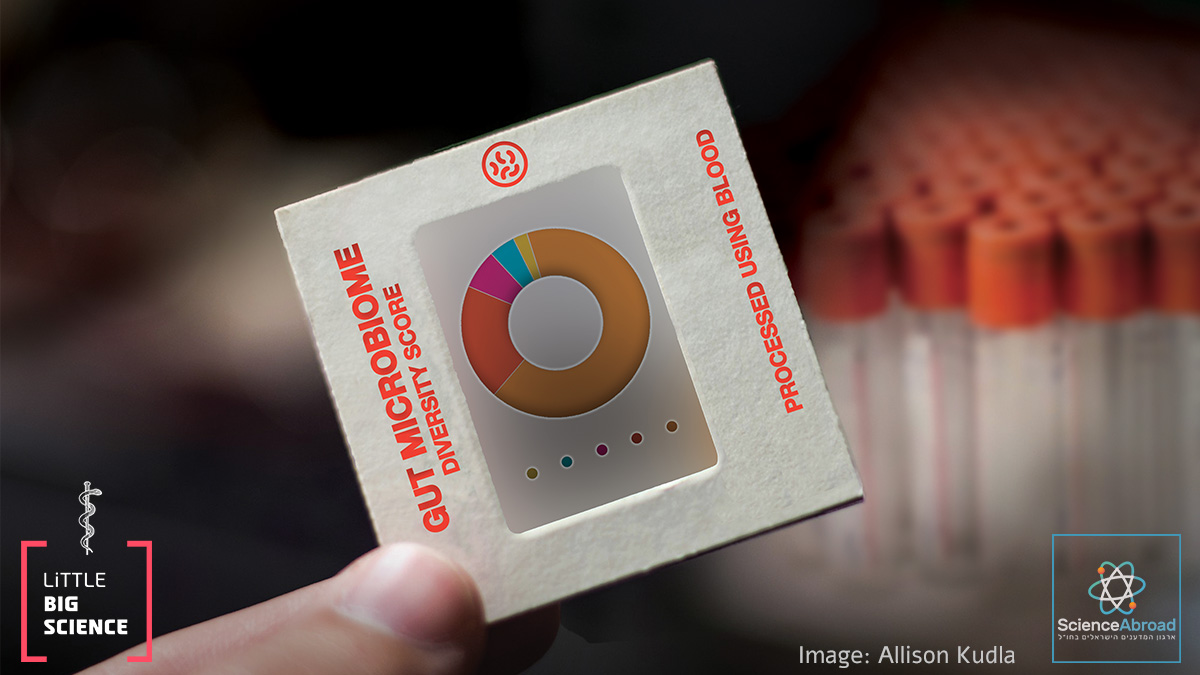
Our gut bacteria play an important role in the development and function of our immune and digestive systems, but they also contribute to various diseases. Nevertheless, there is still no definition of what constitutes a “healthy” composition, or whether such a composition even exists. In a paper recently published in Nature Biotechnology, a research team co-led by Dr. Noa Rappoport and Dr. Tomasz Wilmanski from the Institute for Systems Biology in Seattle found that a small set of blood metabolites—compounds produced during the body’s metabolic processes—reflects the composition of gut bacteria [1]. This discovery may help develop blood tests to monitor the microbiome’s composition and to detect disease states that disrupt its bacterial diversity.
Advertisement
We share a complex relationship with the microbiome—all the bacteria and other microorganisms—in our intestines. So complex, in fact, that some view the microbiome as an additional organ in the body. Among other roles, gut bacteria help us digest and absorb nutritional components that would otherwise be unavailable to us, and they support the development and function of our immune system [2, 3]. Despite extensive recent advances in characterizing and studying the gut microbiome, we still cannot determine what comprises a “healthy” population of microorganisms. A major challenge is that people in different geographic regions are exposed to distinct environments and consume different foods, resulting in entirely different bacterial compositions in terms of species and abundance, which complicates applying findings from one study cohort to another [4].
One useful and consistent measure for profiling gut bacteria is bacterial diversity in the intestine. Several diversity indices consider both the number of different bacterial taxa and their abundance. In general—a more diverse gut population containing a greater variety of bacteria is considered healthier, whereas a limited bacterial population has been linked to various disease states, such as Crohn’s disease and diabetes [5, 6].
Our blood contains thousands of small molecules (metabolites) that participate in the body’s metabolism. Some come directly from our diet, and others are produced in cooperation with gut bacteria. The bacteria use our food as their growth medium, and after they process it and extract what they need, they release the products, which are then absorbed into the bloodstream. Recent technological advances now allow us, at relatively low cost, to measure metabolite levels using a single drop of blood.
The research paper described herein tests the hypothesis that blood metabolites could reflect the composition of our gut microbiota. The researchers also proposed that although specific bacterial species can differ among individuals from various environments, diets, and regions, their impact on our metabolism in health or disease might be similar.
To test this hypothesis, the researchers used machine-learning algorithms. The algorithm received information on the gut bacterial composition of about 400 individuals for whom blood metabolite levels were also measured. Then, it “learned” which metabolites could predict the diversity index of the gut microbiota. The predictions were then assessed in a separate group of participants who had not taken part in the training phase. To the researchers’ surprise, not only was predicting gut microbial diversity from blood metabolites feasible, but the prediction relied on a small subset of just 40 metabolites out of more than 650 measured (termed the ‘metabolic signature’). The metabolic signature reflected gut diversity even under conditions that dramatically affected the gut population, such as antibiotic use or intestinal diseases. The strong link between the metabolic signature and the gut was disrupted only in cases of extreme obesity (BMI > 35), hinting at the extensive metabolic disturbance in this state. Moreover, a minimal set of only 11 metabolites enabled highly accurate identification of individuals whose gut microbiota exhibited relatively low diversity, which, as noted, is associated with multiple disease states [5, 6].
The study yielded another unexpected result. When the researchers applied the same strategy and tried to predict gut bacterial composition from a broad range of standard blood tests or a survey of blood proteins, no successful signatures were found. In other words, the blood tests physicians currently use to monitor our health provide only limited information about the state of our gut bacteria, whose importance to our well-being is becoming increasingly apparent.
Many of the metabolites that composed the metabolic signature involved known microbial contributions. When examining the findings, the researchers observed that some of the metabolites in the signature were associated with negative health outcomes such as kidney failure or heart disease. This suggests that it is not only "the higher, the healthier" when it comes to gut microbial diversity, as previously thought; instead, there may be an optimal diversity range—neither too high nor too low—from a health standpoint.
A practical example of the study’s implications is the early diagnosis of antibiotic-resistant Clostridium difficile infection, a severe intestinal infection responsible for about 15,000 deaths annually in the United States [7]. This complication, characterized by excessively low gut microbial diversity, often follows antibiotic treatments that harm most gut bacteria. A reliable blood test that detects damage to the gut microbiota would allow more effective interventions, such as fecal transplantation as a first-line therapy, sparing patients repeated antibiotic treatment failures.
Further work is required to unravel the complex relationships among our physiology, the gut microbiota, and our health. The researchers suggest that the key to a general definition of a healthy gut microbiota lies in examining its metabolic signature—its reflection in the bloodstream—which the study indicates is more stable and easier to measure. This work paves the way toward a blood test that monitors gut microbial health and, ultimately, toward effective drug or dietary interventions for a variety of diseases.
English editing: Elee Shimshoni
This text was written by Dr. Noa Rappaport from the ScienceAbroad association in collaboration with Little, Big Science.
Dr. Noa Rappaport is a research scientist at the Institute for Systems Biology in Seattle in the lab of Lee Hood and Nathan Price. She earned her master’s degree at the Weizmann Institute under the supervision of Prof. Naama Barkai, focusing on mathematical modeling of biological processes, and completed her PhD in the same lab, concentrating on fungal drug resistance. She then pursued a post-doctoral fellowship in Prof. Doron Lancet’s lab, focusing on developing biological databases.
ScienceAbroad is a non-profit organization that, since 2006, has been uniting Israeli scientists abroad. Its goal is to strengthen ties with Israeli researchers worldwide and promote their return to Israel. The ScienceAbroad community numbers more than 3,000 researchers from the world’s leading universities. The organization provides tools, builds connections, and opens doors for Israeli scientists seeking to return to Israel, so they can bring their knowledge, experience, and connections gained abroad to Israeli academia and industry as a growth engine. In addition, members are involved in projects that improve Israel’s image and brand the country as a center of research and development, as well as make science accessible to the general public in Israel and worldwide.
References:
- Original article: Blood metabolome predicts gut microbiome α-diversity in humans
- Duvallet, C., Gibbons, S. M., Gurry, T., Irizarry, R. A. & Alm, E. J. Meta-analysis of gut microbiome studies identifies disease-specific and shared responses. Nat. Commun. 8, 1784 (2017).
- Shreiner, A. B., Kao, J. Y. & Young, V. B. The gut microbiome in health and in disease. Curr. Opin. Gastroenterol. 31, 69–75 (2015).
- He Y, Wu W, Zheng HM, Li P, McDonald D, Sheng HF, Chen MX, Chen ZH, Ji GY, Zheng ZD, Mujagond P, Chen XJ, Rong ZH, Chen P, Lyu LY, Wang X, Wu CB, Yu N, Xu YJ, Yin J, Raes J, Knight R, Ma WJ, Zhou HW. Regional variation limits applications of healthy gut microbiome reference ranges and disease models. Nature Medicine. 2018;24:1532–1535. doi: 10.1038/s41591-018-0164-x
- Gong D, Gong X, Wang L, Yu X, Dong Q. Involvement of Reduced Microbial Diversity in Inflammatory Bowel Disease. Gastroenterol Res Pract. 2016;2016:6951091. doi:10.1155/2016/6951091
- Mosca A, Leclerc M, Hugot JP. Gut Microbiota Diversity and Human Diseases: Should We Reintroduce Key Predators in Our Ecosystem?. Front Microbiol. 2016;7:455. Published 2016 Mar 31. doi:10.3389/fmicb.2016.00455
- Bakken, J. S., Borody, T., Brandt, L. J., Brill, J. V., Demarco, D. C., Franzos, M. A., et al. Treating Clostridium difficile infection with fecal microbiota transplantation. Clin. Gastroenterol. Hepatol. 9, 1044–1049 (2011).
Links for further reading:
https://bioengineeringcommunity.nature.com/users/297617-noa-rappaport/posts/52687-the-reflection-of-gut-microbiota-in-the-bloodstream







